http://www.chemistrymag.org/cji/2009/116028pe.htm |
Jun.1,
2009 Vol.11 No.6 P.28 Copyright |
(College of Chemistry and Environmental Science, Hebei University, Key Laboratory of Analytical Science and Technology of Hebei Province, Baoding 071002, China)
Abstract: A new diamine
functionalized glass fibre sorbent was prepared for preconcentration and separation of
toxic metal ions from aqueous solution by loading tetraethoxysilicate (TEOS) and
N-(2-aminoethyl)-3-aminopropyltrimethoxysilane (AAPTS) on glass fibre through a sol-gel
process. The new sorbent provided good acid-base stability, fast adsorption and desorption
kinetics (no loss of adsorption and desorption efficiencies at flow rates up to at least
11.6 mL min-1). The dynamic capacity for 2 mg L-1 Cd(II) and 1.5 mg
L-1 Cu(II) at a loading flow rate of 5.6 mL min-1 was 0.146 and
0.150 mmol g-1, respectively. The applicability of the developed sorbent for
on-line preconcentration and separation of trace Cd(II) and Cu(II) in environmental and
biological materials was demonstrated by a hyphenated technique of flow injection
microcolumn coupled on-line with flame atomic absorption spectrometry. With a sample
loading flow rate of 9.6 mL min-1 for 30 s preconcentration, the enhancement
factors of 124 for Cd(II) and 61 for Cu(II), and the detection limits (3s ) of 14 ng L-1
for Cd(II) and 31 ng L-1 for Cu(II) were achieved at a sampling frequency of 80
h-1. The precision (RSD) for 11 replicate preconcentrations of 4 m g L-1
Cd(II) and 10 m g L-1 Cu(II) was 0.8% and 0.5%, respectively. The new sorbent
also offered good linearity (g >0.9995) for on-line preconcentration of trace Cd(II)
and Cu(II).
Keywords Sorbent; Sol-Gel Process; on-line Separation and
Preconcentration; Copper and Zinc
Development of new sorbents for separation and preconcentration of toxic metal ions in complicated matrices plays an important role in environmental analysis and clean-up.1-5 Solid-phase extraction is a very promising technique for separation and preconcentration, its development is based on designing new solid sorbents with high sorption capacity, selectivity and suitability for on-line applications.
One of the most widely used supporting materials for preparing selective sorbents is inorganic solid support, such as silica gel and controlled pore glass.6, 7 Recently, glass fibre have gained growing interest as an important support for the immobilization of biological proteins, which has been found wide application in both analytical and preparative systems.8, 9 Glass fibre, a flexile, widely available material, holds many remarkable advantages compared with other support, including low cost (unlike controlled porosity glasses), excellent mechanical strength, durability, thermal stability, good kinetic characteristics, and its easy modification with various functional groups.
Surface modification of glass fibre to obtain sorbents with desired functional groups is made possible via the SiOH groups. However, the inherent limitation in the availability of hydroxyl groups on the surface of glass fibre leads to small metal adsorption capacity. To increase the adsorption capacity and the immobilization layer stability, a sol-gel method was used in modifying glass fibre, and then the functional groups were introduced onto the surface.9 N-(2-aminoethyl)-3- aminopropyltrimethoxysilane (AAPTS) was used to reinforce fibres.10 Immobilization of AAPTS on glass fibre may be easily converted into various chelating groups with the specificity toward metal cations (such as dithiocarbamates11) and the immobilization of biological proteins.
In the present work, a new diamine-functionalized glass fibre sorbent (AAP-GW) was synthesized by loading tetraethoxysilicate (TEOS) and N-(2-aminoethyl)-3-aminopropyltrimethoxysilane (AAPTS) on glass fibre through a sol-gel process, and evaluated for on-line preconcentration and separation of toxic metal ions from aqueous solution using Cd(II) and Cu(II) as model metal ions. 2. EXPERIMENTAL
2.1 Materials and chemicals
All reagents used were of the highest available purity and at least of analytical grade. All metal stock solutions (100 mg L-1) were purchased from National Research Center for Standard Materials (NRCSM, Beijing, China). The working solutions were prepared by series dilution of the stock solutions immediately prior to use. Doubly deionized water (DDW, 18.2 MΩ cm) obtained from a WaterPro water system (Labconco Corporation, Kansas, MO, USA) was used throughout the experiments. Two silane agent, Tetraethoxysilicate (TEOS) and N-(2-aminoethyl)-3- aminopropyltrimethoxysilane (AAPTS, Wuhan University Chemical Factory, Wuhan, China), and glass fibre (WAHLEE Glass Fibre Co., Ltd. Qingdao, China) were used for sorbent preparation.
2.2 Apparatus and conditions
A Model Solaar S2 flame atomic absorption spectrometer (Thermo Elemental Co.) was employed for determination of trace metals. The AAS instrument was controlled by the SOLAARS operation software. Hollow cathode lamps (Beijing Shuguangming Electronic Light Source Instrument, Beijing) were used as the radiation source at 228.8 nm for Cd and 324.8 nm for Cu) with a 0.5-nm slit width. The recommended acetylene flow rates of 1.1 L min-1 were employed. The air flow rates were automatically adjusted to meet the stoichiometric air-acetylene flame conditions.
A Model FIA-3100 flow injection analyzer (Vital Instrumental, Beijing, China) was used to evaluate the applicability of the sorbent for on-line preconcentration and separation of trace Cd(II) and Cu(II). The FIA-3100 consists of two peristaltic pumps and a standard rotary injection valve (8-channel 16-port multifunctional injector). Tygon peristaltic pump tubings were employed to propel the sample and reagent. PTFE tubing with 0.35-mm i.d. was used for all connections. These connections were kept as short as possible to minimize the dead volumes.
2.3 Preparation of Diamine Functionalized Glass Fibre Sorbent
The glass fibre was washed thoroughly with dilute hydrochloric acid, doubly distilled water, boiled in ethanol for 2 h and then dried at 120 ℃ for 12 h. The pretreated glass fibre was stored in a vacuum desiccator for subsequent immobilization.
A sol solution was prepared by dissolving 1 g TEOS in 9 mL of cosolvent of methanol (95% in total solvent) and deionized water (5%) at pH 4.0 (with acetic acid solution) for 20 min. 0.5 g of pretreated glass fibre was soaked in the sol solution for 30 min, isolated from the solution, air-dried, and conditioned at 120 ℃ for 4 h. The conditioned material was soaked in 10 mL of 10 % AAPTS in methanol solution for 4 h, isolated from the solution, and dried under vacuum at 80 ℃ for 12 h. After washing with deionized water, ethanol and deionized water sequentially, the AAPTS immobilized glass fibre (AAP-GW) was neutralized with NaHCO3, washed with deionized water again, dried, and stored in a vacuum desiccator.
For comparison, 10% AAPTS in dry toluene solution, in aqueous solution and in methanol solution were used, respectively, in immobilization of AAPTS on glass fibre without TEOS sol-gel pretreatment.
Determination of the static uptake capacity. 0.1 g of the AAP-GW sorbent was equilibrated with 10 mL of the buffer solution containing 2 mmol L-1 of Cd(II) or 2 mmol L-1 of Cu(II) in stoppered plastic vials and these mixtures were stirred for 30 min at room temperature. The filtrates were measured for uptakes of Cd(II) and Cu(II) by a Model Solaar S2 flame atomic absorption spectrometer.
2.4 Determination of dynamic capacity
The dynamic capacity of the AAP-GW sorbent was determined by passing Cd(II) and Cu(II) solution at optimum pH through a cylindrically shaped PTFE microcolumn (3-cm long ´ 2-mm i.d.) packed with 22 mg of the sorbent at a fixed flow rate until the concentration of the metal ions in the effluent was the same as in the influent. Successively fractions of 10 mL effluent portions were collected, in which the metal contents were measured by FAAS.12 The dynamic capacity was calculated according to Wang and Barnes.13
2.5 Procedures for applicability evaluation of the AAP-GW sorbent for on-line separation and preconcentration
A hyphenated technique, namely flow injection (FI) on-line microcolumn preconcentration and separation coupled with flame atomic absorption spectrometry (FAAS) using a cylindrically shaped microcolumn (3-cm long×2-mm i.d.) packed with 22 mg of the AAP-GW sorbent was employed to evaluate the applicability of the AAP-GW sorbent for on-line separation and preconcentration of trace Cd(II) and Cu(II). The FI manifold and its operation sequence for on-line microcolumn preconcentration and separation are shown in Figure 1 and Table 1, respectively. Table 1. Operational Sequence of the FI On-Line Microcolumn Preconcentration System Coupled with FAAS for Determination of Trace Cd(II) and Cu(II)
step |
function |
time/s |
pumped medium |
flow rate / ml min-1 |
palve position |
|
pump 1 |
pump 2 |
|||||
1 |
sample loading |
30 |
sample solution |
9.6 |
off |
fill |
2 |
elution |
10 |
0.4
mol L-1 HCl for Cd(II) |
off |
5.6 |
injection |
3 |
column regeneration |
5 |
0.2 mol l-1 NH3H2O |
off |
5.6 |
fill |
2.6 Sample digestion
The following certified reference
materials (NRCSM) and real samples were analyzed to check the accuracy of the developed FI
on-line microcolumn preconcentration FAAS technique using the AAP-GW as sorbent: GBW 07605
(tea), GBW 07601 (human hair), GBW 08607 (river water). 0.3500 g of each sample was mixed
with 10 mL concentrated HNO3 and digested in sealed PFA (Teflon-perfluoralkoxy)
vessels using a Model Qwave-2000 microwave digestion system (Questron Co., Canada). All
instrumental parameters for the digestion were chosen according to the recommendations of
EPA. The clear digest was transferred into a 50-mL calibrated flask and diluted to volume
with DDW.
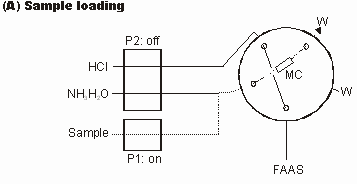
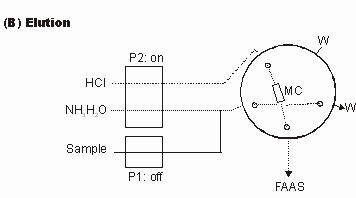
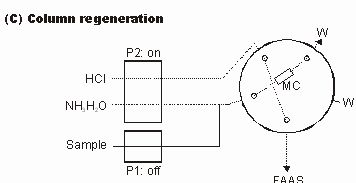
Figure 1 FI manifold for evaluation of the AAP-GW sorbent as a new packing for on-line microcolumn preconcentration and separation of trace metal ions. P1 and P2, peristaltic pumps; MC, microcolumn packed with the AAP-GW sorbent; W, waste; FAAS, flame atomic absorption spectrometer; dotted lines are active.
3. RESULTS AND DISCUSSIONImmobilization of chelating groups onto inorganic silica surfaces is usually carried out by reacting chelating agents with silica substrate through hydroxyl groups on the surface in a toluene solution or an aqueous solution.7 In our preliminary experiments, this method was tried to immobilize diamine group onto glass fibre in toluene, or aqueous, or methanol solution, resulting in low adsorption capacity owing to an inherent limitation in the availability of hydroxyl groups on the surface of glass fibre. Moreover, the sorbents prepared in this way could not suffer higher temperatures due to serious hydrolysis (hydrolysis degree 20-40%, at pH > 8.0) through breaking the bond between the immobilized chelating agent and the surface of glass fibre under alkaline conditions.
To overcome the above problems, we employed a sol-gel process to prepare the diamine functionalized glass fibre sorbent in aqueous solution by loading TEOS and AAPTS on the surface of glass fibre. This method increased the ligand density on the glass fibre surface, metal uptake capacity, and chemical stability of the prepared sorbent. In the following sections, the results for chemical stability, adsorption and desorption characteristics of the sorbent, and the applicability of the sorbent for on-line preconcentration and separation were presented and discussed.
3.1 Immobilization efficiency
The elemental analysis of the AAP-GW for amido suggested a higher free group content of the 1.21 mmol N g-1 (AAP-GW), corresponding to 0.61 mmol (AAP) g-1 (AAP-GW). The static uptake capacity of the AAP-GW sorbent was determined to be 0.236 and 0.242 mmol g-1 for Cd(II) and Cu(II), respectively. It was found that the static capacity of the AAP-GW sorbent after storing for more than 6 months under ambient conditions was still practically unchanged.
3.2 Dynamic capacity of the AAP-GW sorbent
The dynamic capacity describes the operational characteristics of a sorbent in the column operation mode. The theoretical value depends upon the nature of the material and the form of the sorbent, the operational capacity is usually lower than the available capacity, and depends on several experimental factors such as flow rate, temperature, and concentration of the loading solution. Besides, the "breakthrough" of solution from the column defines a dynamic capacity (working capacity), which is lower than the total capacity.12 The dynamic capacity corresponds to the maximum amount of analyte that is retained with minimum leakage of the element from the influent solution. The volume of solution percolated from the breakthrough point to the point of leveling of the loading curve for a given solution flow rate also depends upon the uptake kinetics.12
The dynamic capacity of the sorbent was determined by pumping Cd(II) or Cu(II) solution through a column packed with 22 mg of the AAP-GW sorbent and collecting successive volumes of 10 mL of effluent. The concentration (Ci) of metal in each effluent fraction was measured by FAAS, and the ratio of Ci to the concentration of the influent loading solution (C0) was plotted against the effluent volume.
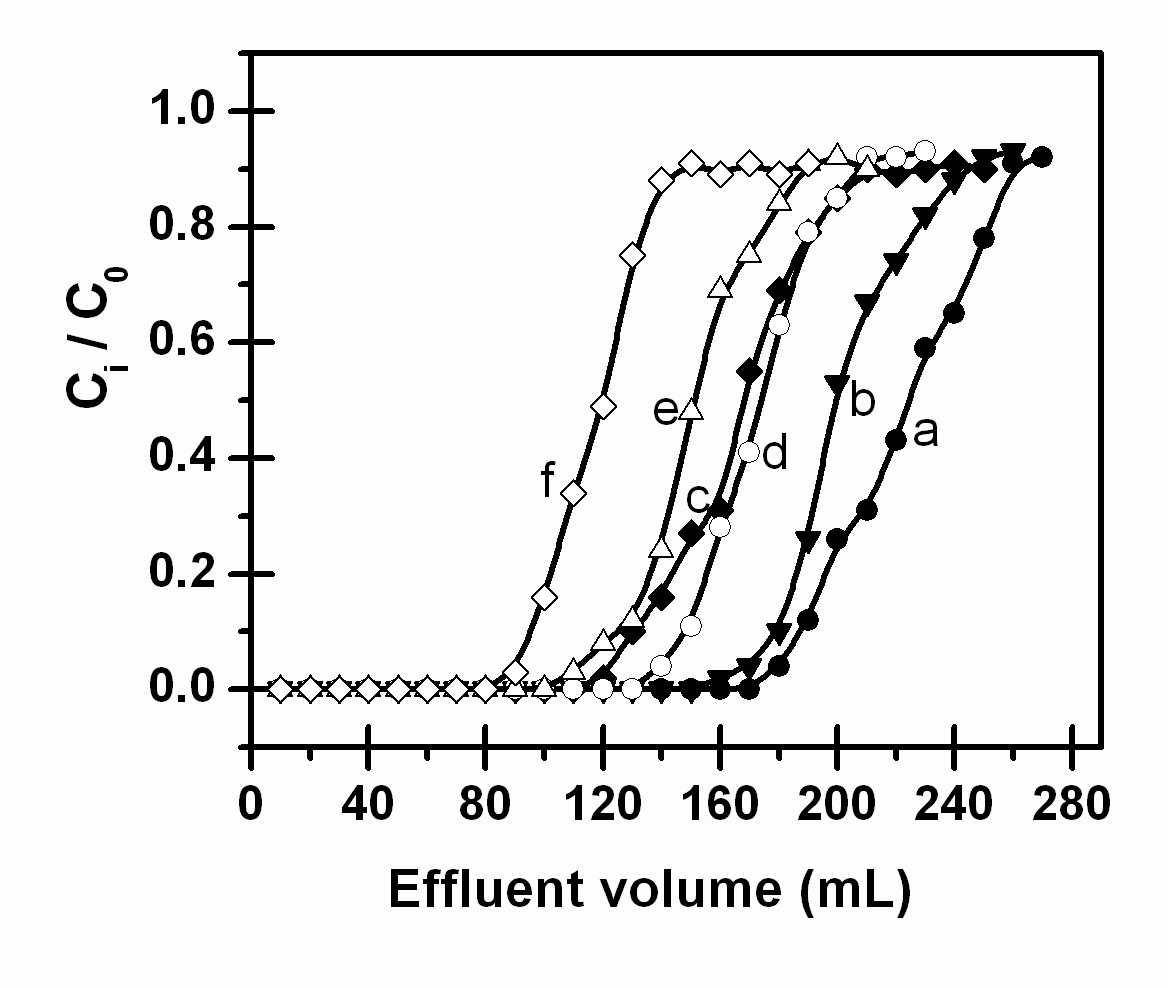
Figure 2. Dynamic capacity curves of the AAP-GW sorbent for 2 mg L-1 Cd(II) (a, b, c)and 1.5 mg L-1 Cu(II) (d, e, f) solution (pH 3.6-4.0) loaded at flow rates of 2.7 (a, d), 5.2 (b, e), and 8 (c, f) mL min-1
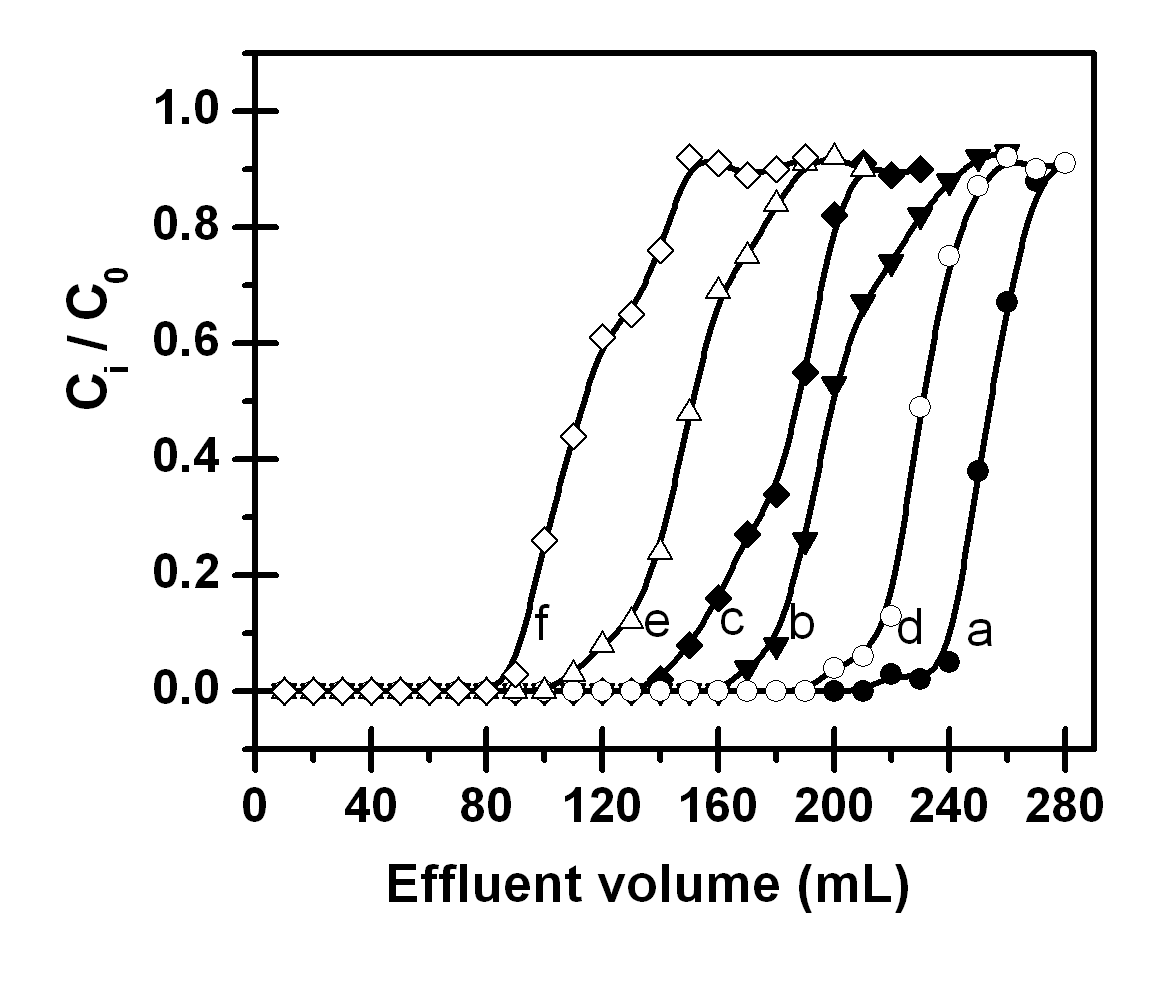
Figure 3. Dynamic capacity curves of
the AAP-GW sorbent for the different influent concentrations of Cu(II) and Cd(II) solution
(pH 3.6-4.0) loaded at a flow rate of 5.2 mL min-1. Cd (mg L-1): (a)
1.5, (b) 2, and (c) 2.5; Cu (mg L-1): (d) 1, (e) 1.5 and (f) 2.
The effect of sample
loading flow rate on the breakthrough point was displayed in Figure 2. The results show
that, at a given concentration (2 mg L-1 Cd(II) and 1.5 mg L-1
Cu(II)), the dynamic capacity decreased with increasing of sample loading flow rate
although the leveling of the curves at Ci /C0 = 1 is
not reached. The slope of the ascending portion of the curve also suggests a higher
adsorption rate. The effect of the concentration of the metal ion in influent solution on
breakthrough point is shown in Figure 3. The results show that at a given sample loading
flow rate (5.2 mL min-1), the breakthrough capacity increased as the
concentration of the metal ion in influent solution decreased. These results indicate that
at low flow rates and low metal concentrations, a large dynamic capacity can be obtained.
The dynamic capacities (work capacities) for 2 mg L-1 Cd(II) and 1.5 mg L-1
Cu(II) at a fixed sample loading flow rate (5.2 mL min-1) were calculated to be
0.146 and 0.150 mmol g-1, respectively.
3.3 Evaluation of the AAP-GW Sorbent for
On-Line Preconcentration and Separation of Trace Metal Ions
The applicability of the AAP-GW sorbent
as a microcolumn packing for on-line preconcentration and separation of trace toxic metal
ions was evaluated using a hyphenated technique, FI preconcentration and separation
on-line coupled with FAAS. The chemical and flow variables, such as sample acidity, sample
loading flow rate and loading time, eluent and its concentration and flow rate,
regeneration agents and their concentrations, were optimized to achieve good sensitivity
and precision for the retention and elution of Cd(II) and Cu(II).
Sample acidity plays
an important role in the complex sorption preconcentration because it affects the complex
form between metal ions and functional ligands. The influence of sample acidity on the
preconcentration of 4 m g L-1 Cd(II)and 10 m g L-1 Cu(II) were
examined at a sample loading rate of 9.6 mL min-1 with 30-s preconcentration.
As shown in Figure 4, the progressive decrease in the absorbance at lower pH is due to the
protonation of the amine moiety, which diminished the ability of the amine group to
involve in chelate formation with Cd(II) and Cu(II). At pH > 6, precipitation of the
metal hydroxide occurred, and therefore the absorbance of the analytes decreased as the
sample pH increased. For further experiments, a pH range of 3.6-4.0 was used for the
preconcentration.
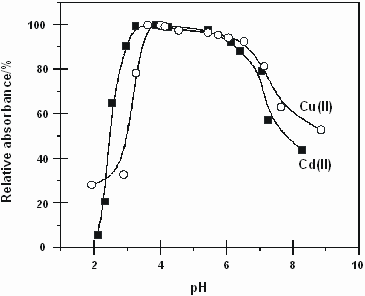
Figure 4. Effect of pH on the on-line preconcentration of 4 mg L-1 Cd(II) and 10 mg L-1 Cu(II).
All other conditions as in Table 1.
The effect of sample
loading time on the preconcentration of 0.5 m g L-1 Cd(II) and 1 m g L-1
Cu(II) was tested at a sample loading flow rate of 9.6 mL min-1. It was found
that the absorbance increased almost linearly as sample loading time up to 240 s. Studies
on the effect of sample loading flow rate on the preconcentration of 4 m g L-1
Cd(II) and 10 m g L-1 Cu(II) for 30 s showed that the absorbance increased
linearly as sample loading flow rate increased up to 11.6 mL min-1. These
results indicated that the kinetics for the adsorption of Cu(II) and Cd(II) by the
developed sorbent was fairly fast. The wide range of linearity shows the sorbent offered
great potential application in flow injection on-line microcolumn preconcentration system
for achieving high enhancement factors by increasing sample loading rates and/or sample
loading time without losing retention efficiency.
Diluted hydrochloric acid was chosen for on-line elution of the
retained analytes from the microcolumn packed with the AAP-GW. The effects of HCl
concentration, its flow rate and elution time on the elution of the retained Cu(II) and
Cd(II) was examined. It was found that 0.4 and 0.8 mol L-1 of HCl solution at a
flow rate of 5.6 mL min-1 for 10 s elution of the retained Cd(II) and Cu(II)
respectively was optimum for sensitivity and precision.
Once cadmium and copper elution were complete, the sorbent should be
neutralized for the de-protonation of the amine moiety to recover the complex ability of
the amine group. It was found that a 0.2 mol L-1 of ammonia solution at a flow
rate of 5.6 mL min-1 applied for rinsing the microcolumn for 5 s after elution
was quite efficient for this purpose.
The selectivity of the sorbent for on-line preconcentration of Cd(II)
and Cu(II) was demonstrated by studying the effect of coexisting metal ions on the
recovery of 4 m g L-1 Cd(II) and 10 m g L-1 Cu(II). As shown in
Table 2, the presence of up to 150 mg L-1 of Na(I), 20 mg L-1 of
Mg(II), 60 mg L-1 of Ca(II), 0.8 mg L-1 of Fe(III), 1 mg L-1
of Cr(III) and Zn(I), 2 mg L-1 of Ni(II), 1.5 mg L-1 of Pb(II), and
0.45 mg L-1 of Cu(II) had no significant interference with the on-line
preconcentration of 4 m g L-1 Cd(II).
The tolerable concentrations of Na(I), Mg(II), Ca(II), Fe(III),
Cr(III), Zn(II), Ni(II), Pb(II), and Cd(II) for the on-line preconcentration of 10 m g L-1
Cu(II) were found to be 600, 50, 100, 3, 1, 1.5, 4, 3 and 0.4 mg L-1,
respectively. As demonstrated later, the present system allowed the interference-free
preconcentration of trace Pb and Cd in the environmental and biological samples studied.
Table 2. Effect of Coexisting Ions on the On-Line Preconcentration of 4 m g L-1 Cd(II) and 10 m g L-1 Cu(II)
Coexisting ion |
concentration |
Cd(II) |
concentration |
Cu(II) |
|||
[M]/[Cd] |
recovery (%) |
[M]/[Cu] |
recovery (%) |
||||
Na(I) |
80 |
20 000 |
99 ± 3 |
400 |
40 000 |
99 ± 4 |
|
100 |
25 000 |
92 ± 5 |
600 |
60 000 |
91 ± 3 |
||
150 |
37 500 |
84 ± 2 |
800 |
80 000 |
80 ± 2 |
||
Mg(II) |
10 |
2 500 |
98 ± 1 |
40 |
4 000 |
96 ± 3 |
|
20 |
5 000 |
91 ± 2 |
50 |
5 000 |
88 ± 4 |
||
30 |
7 500 |
77 ± 3 |
60 |
6 000 |
78 ± 2 |
||
Ca(II) |
50 |
12 500 |
99 ± 3 |
80 |
8 000 |
98 ± 2 |
|
60 |
15 000 |
93 ± 2 |
100 |
10 000 |
91 ± 2 |
||
80 |
20 000 |
72 ± 2 |
120 |
12 000 |
82 ± 2 |
||
Fe(III) |
0.5 |
125 |
96 ± 3 |
2 |
200 |
94 ± 3 |
|
0.8 |
200 |
87 ± 2 |
3 |
300 |
85 ± 5 |
||
1 |
250 |
79 ± 1 |
6 |
600 |
71 ± 6 |
||
Fe(II) |
0.5 |
125 |
98 ± 2 |
1 |
100 |
98 ± 2 |
|
1 |
250 |
91 ± 2 |
1.5 |
150 |
90 ± 2 |
||
2 |
500 |
73 ± 4 |
2 |
200 |
79 ± 3 |
||
Zn(II) |
0.5 |
125 |
98 ± 3 |
1 |
100 |
102 ± 3 |
|
1 |
250 |
96 ± 1 |
1.5 |
150 |
93 ± 4 |
||
2 |
500 |
82 ± 1 |
2 |
200 |
83 ± 2 |
||
Cr(III) |
0.8 |
200 |
101 ± 1 |
0.8 |
80 |
97 ± 3 |
|
1 |
250 |
94 ± 2 |
1 |
100 |
84 ± 4 |
||
1.5 |
375 |
83 ± 3 |
1.5 |
150 |
73 ± 4 |
||
Ni(II) |
1 |
250 |
98 ± 2 |
2 |
200 |
96 ± 4 |
|
2 |
500 |
89 ± 2 |
4 |
400 |
87 ± 3 |
||
5 |
1 250 |
77 ± 1 |
8 |
800 |
78 ± 2 |
||
Pb(II) |
1 |
250 |
99 ± 3 |
2 |
200 |
98 ± 3 |
|
1.2 |
300 |
92 ± 4 |
2.5 |
250 |
90 ± 4 |
||
1.5 |
375 |
86 ± 2 |
3 |
300 |
86 ± 2 |
||
Cu(II) |
0.2 |
50 |
101 ± 2 |
||||
0.4 |
100 |
98 ± 1 |
|||||
0.45 |
113 |
86 ± 3 |
|||||
Cd(II) |
0.2 |
20 |
98 ± 2 |
||||
0.4 |
40 |
90 ± 3 |
|||||
0.5 |
50 |
76 ± 4 |
|||||
3.4 Figures of Merit for the Application of the AAP-GW Sorbent in FI On-Line Microcolumn Preconcentration and Separation FAAS
Table 3. Analytical Performance of the FI On-line Microcolumn Preconcentration Coupled with FAAS for Determination of Trace Cd(II) and Cu(II)
Cd |
Cu |
|
preconcentration time/s |
30 |
30 |
enhancement factor |
124 |
61 |
sampling frequency/h |
80 |
80 |
sample consumption/mL |
4.8 |
4.8 |
eluent consumption/mL |
0.93 |
0.93 |
precision (RSD, n = 11)% |
0.8 (4 m g L-1) |
0.5 (10 m g L-1) |
detection limit (3s )/ng L-1 |
14 |
31 |
range of calibration graph/m g L-1 |
0.5-30 |
2-40 |
calibration function (N = 6) |
A = 0.022C + 0.0095 |
A = 0.0097C + 0.0042 |
| correlation coefficient | 0.9995 | 0.9998 |
3.5 Validation of the Developed FI On-Line Microcolumn Preconcentration and Separation FAAS System Using the AAP-GW Sorbent
A number of certified reference materials (CRMs), GBW 08607 (River Water), GBW 07601 (Human Hair) and GBW07605 (Tea), were analyzed to evaluate the accuracy of the AAP-GW sorbent-based FI on-line microcolumn preconcentration and separation coupled with FAAS. As shown in Table 4, the concentrations of Cd and Cu in these CRMs obtained by the present method using simple aqueous standard calibration agreed well with the certified values, demonstrating the applicability of the developed FI on-line microcolumn preconcentration system coupled with FAAS for the determination of trace Cd and Cu in the environmental and biological samples studied. Table 4. Analytical Results (m g g-1, mean ± σ, n = 3) for the Determination of Trace Cadmium and Copper in the Certified Reference Materials (CRMs)
sample |
concentration of Cd |
concentration of Cu |
|||
certified |
determined |
certified |
determined |
||
GBW 08607 |
0.100 ± 0.02 |
0.095 ± 0.02 |
1.00 ± 0.01 |
0.974 ± 0.03 |
|
GBW 07601 |
0.11 ± 0.03 |
0.10 ± 0.02 |
10.6 ± 1.21 |
10.1 ± 1.44 |
|
GBW 07605 |
0.057 ± 0.010 |
0.048 ± 0.02 |
17.3 ± 1.82 |
15.5 ± 2.23 |
|
A new diamine functionalized glass fibre sorbent was prepared for preconcentration and separation of toxic metal ions from aqueous solution by loading tetraethoxysilicate (TEOS) and N-(2-aminoethyl)-3-aminopropyltrimethoxysilane (AAPTS) on glass fibre through a sol-gel process. The new sorbent provided good acid-base stability, fast adsorption and desorption kinetics, and good linearity, making the material very suitable for its application in FI on-line microcolumn preconcentration and separation systems. Acknowledgements
This work was supported by National Science Foundation of China (No. 20675024), Natural Science Foundation of Hebei Educational Committee (No. 2006407), China Postdoctoral Science Foundation (No. 2005037629) and Science Foundation of Hebei University. REFERENCES
[1] Fang Z.L. Flow Injection Atomic Absorption Spectrometry, Wiley, Chichester, 1995.
[2] Yan X.P., Jiang Y. Trends Anal. Chem., 2001, 19: 552.
[3] Sabermahani F., Taher M.A. Anal. Chim. Acta, 2006, 565: 152.
[4] Yan X.P., Sperling M., Welz B. Anal. Chem., 1999, 7: 4216.
[5] Camel V. Spectrochim. Acta Part B, 2003, 58: 1177.
[6] Simpson N.J.K. Solid Phase Extraction, Principles, Techniques and Applications, Marcel Dekker, New York, 2000.
[7] Biernat J.F., Konieczka P., Tarbet B.J., et al. Speparation and Purification Methods, 1994, 23: 77.
[8] Nisnevitch M., Kolog-Gulco M., Trombka D., et al. J. Chromagra. B, 2000, 738: 217.
[9] Zusman R., Zusman I.J. Biochem. Biophys. Methods, 2001, 49: 175.
[10] Park S.J., Jin J.S. J. Colloid Interface Sci., 2001, 242: 174.
[11] Hercules D.M., Cox L.E., Onisick S., et al. Anal. Chem., 1973, 45: 1973.
[12] Malla M.E., Alvarez M.B., Batistoni D.A. Talanta, 2002, 57: 277.
[13] Wang X.R., Barnes R.M. J. Anal. Atom. Spectrom., 1989, 4: 509.
[14] Mahmoud M.E. Anal. Lett., 1996, 29: 1791. 氨基功能化玻璃棉吸附剂的溶胶-凝胶法制备与评价及其在线分离富集有毒金属离子
吕运开*,陆国栋,秦新英,刘 越
(河北大学化学与环境科学学院,河北省分析科学技术重点实验室,河北 保定 071002)
摘要 采用四乙基硅氧烷和N-(2-氨基乙氨基)丙基三甲氧基硅烷(AAPTS)的溶胶-凝胶过程,在玻璃纤维表面接枝二氨基,发展了一种新的富集分离水溶液中有毒有害金属离子的方法。这种新的吸附剂具有较好的酸碱稳定性、快速吸附-解吸的动力学性质(流速可达到11.6 mL min-1)。在流速为5.6 mL min-1,金属离子浓度为2 mg L-1 Cd(II)和 1.5 mg L-1 Cu(II)的条件下,动态吸附容量分别为 0.146 和 0.150 mmol g-1。将吸附剂用作流动注射与火焰原子吸收的在线富集分离环境样品和生物样品中痕量的Cd(II) 和 Cu(II)。在流速为9.6 mL min-1 ,富集时间为30 s的条件下,富集因子为124 for Cd(II) 和 61 Cu(II);Cd(II) 和Cu(II)检出限(3s )分别为14 ng L-1 和31 ng L-1;进样频率为80 h-1;采用浓度为4 m g L-1 Cd(II) 和 10 m g L-1 Cu(II) ,重复试验11次,测定的精密度(RSD)分别为 0.8% 和 0.5%,较宽的线性范围和较好的线性(g >0.9995)。
关键词 吸附剂;溶胶-凝胶过程;在线分离富集;镉和铜